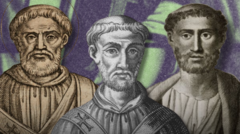
North Africa's Papal Legacy: Examining the Historical Record
The papacy, a cornerstone of the Catholic Church, has a rich and complex history spanning millennia. While figures from Italy and other European nations are commonly associated with the position, historical evidence suggests a notable connection between North Africa and the Holy See. Several popes, according to historians, originated from North Africa, leaving their mark on the early development of the Church. This article delves into the historical record to examine the evidence for these claims and explore the significance of North Africa's contribution to the papacy.
Identifying the North African Popes
Determining the precise origins and ethnic backgrounds of historical figures can be challenging due to limited and sometimes conflicting documentation. However, scholarly consensus points to three popes with identifiable North African roots:
- Pope Victor I (189-199 AD): Widely considered the first African pope, Victor I is believed to have been born in the Roman province of Africa, which encompasses modern-day Tunisia, Libya, and eastern Algeria. His pontificate was marked by controversies surrounding the Quartodeciman controversy, a dispute over the proper date for celebrating Easter.
- Pope Miltiades (311-314 AD): Also known as Melchiades, he reigned during a crucial period in Christian history, following the Edict of Milan which granted religious toleration in the Roman Empire. Miltiades' African origins are generally accepted by historians. He dealt with the aftermath of the Diocletianic Persecution and the Donatist controversy.
- Pope Gelasius I (492-496 AD): Often cited as the last pope of North African descent, Gelasius I played a significant role in defining papal authority and solidifying the Church's doctrine. He was born in Rome, but his family is believed to have originated from North Africa. His writings are crucial to understanding the development of papal ideology during late antiquity.
Evidence and Historical Context
The evidence for the North African origins of these popes varies. In the case of Victor I and Miltiades, historical accounts directly state their African origins. For Gelasius I, the evidence is more indirect, based on the known presence of North African communities in Rome during that period and the traditions surrounding his family name. It's crucial to note that "North African" in this context refers to the Roman provinces of North Africa, a diverse region encompassing various ethnic groups and cultures.
The period in which these popes lived was a time of significant transformation for both the Roman Empire and the early Church. North Africa was a vital part of the Roman world, a source of agricultural wealth, intellectual ferment, and manpower. The region also boasted a vibrant Christian community, producing theologians like Tertullian, Cyprian, and Augustine, whose ideas profoundly shaped Christian thought. The presence of North African popes reflects the importance of the region in the early Church.
The Significance of North Africa's Papal Contribution
The fact that three popes hailed from North Africa highlights the universality of the early Church and its ability to transcend geographical and cultural boundaries. These popes played important roles in shaping Church doctrine, asserting papal authority, and navigating the complex political landscape of the late Roman Empire. Their contributions are a testament to the intellectual and spiritual vitality of the North African Christian community.
The legacies of these popes extended far beyond their individual pontificates. Their actions and pronouncements helped to solidify the foundations of the papacy and define the role of the Church in the Western world. While over 1500 years have passed since the last pope of confirmed North African descent, their presence in the historical record serves as a reminder of the diverse origins of the papacy and the enduring impact of North Africa on the development of Christianity.
Challenges in Researching Ancient Papal History
Reconstructing the lives and backgrounds of early popes presents numerous challenges. Primary sources are often scarce, fragmented, or biased. Historians rely on a combination of papal biographies, letters, decrees, and archaeological evidence to piece together the historical record. However, these sources must be carefully scrutinized and interpreted within their historical context. Furthermore, the concept of national identity was different in antiquity, making it difficult to apply modern definitions of ethnicity and nationality to historical figures. This requires a nuanced understanding of the Roman world and the complexities of early Christian history.
For example, the Liber Pontificalis, a collection of papal biographies compiled over several centuries, is a key source of information about early popes. However, the Liber Pontificalis is not always accurate, and its accounts are often embellished with legendary material. Therefore, historians must cross-reference its claims with other sources to verify their accuracy.
Conclusion
The historical record suggests that North Africa played a significant role in the early papacy. Popes Victor I, Miltiades, and Gelasius I, all believed to have North African roots, left their mark on the Church during a critical period of its development. Their contributions reflect the intellectual and spiritual vibrancy of the North African Christian community and highlight the universality of the early Church. While the challenges of historical research make it difficult to reconstruct their lives in detail, their presence in the papal lineage serves as a lasting testament to the enduring connection between North Africa and the Holy See.
